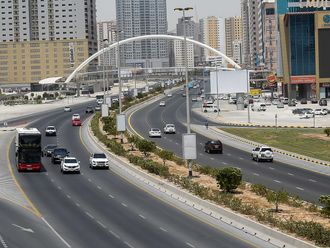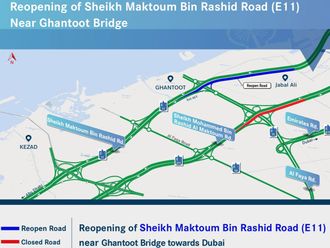
Abu Dhabi: Living in Abu Dhabi emirate, you may have found it hard to convey your exact address to the pizza delivery service. Or it may be confusing to tell your friend from out of town exactly which street you live on so they can get to your place easily.
However, these challenges are all being resolved by the Onwani system, which has not only assigned unique names for major roads in the capital but is also focussing on identifying each building with a dedicated number.
“Onwani is an innovative new system for the emirate that standardises the naming and location of places for the ease of way finding,” said Dr Abdullah Al Beloushi, executive director for property management, property regulations and registrations at the Department of Municipal Affairs (DMA).
Under Onwani, the unified addressing and location mapping system, the capital’s major thoroughfares are being renumbered so that motorists can find streets using a logical sequence of numbers. Officials anticipate that these changes will not only make it easier for residents and visitors to get around the growing city, but also enable emergency responders and delivery services to reach destinations more quickly.
The system was launched in 2013 by the Department of Municipal Affairs (DMA) in Abu Dhabi.
One of the first steps undertaken was to eliminate duplicate names for major roads in Abu Dhabi city, and to assign official names to them. This was essential as many streets in Abu Dhabi were, and often still are, referenced by multiple names. For example, Zayed The First Street in Abu Dhabi is popularly known as Electra Street, while the renamed Fatima Bint Mubarak Street was varyingly known as Bani Yas Street, Najda Street and 6th Street.
A specialised committee worked to agree upon 19,000 new names for roads besides names for 240 new neighbourhoods in the emirate. The names reflect cultural and historical significance, and many are based upon the identities of historical personalities who helped shape the UAE and the Arab World.
New signage
The list of new names was followed by the erection of new road signs, with blue and purple indicating the major roads. According to the DMA, about 48,000 of these signs will be erected across the emirate as part of Onwani.
“Over [2015], the Municipality of Abu Dhabi City will be installing just under 17,000 new street name signs. Already, they have rolled out 110 new street signs in the areas of Bahia, Al Falah and Al Nahyan, and 720 other signboards have been put up in the city’s main roads,” DMA officials told Gulf News.
Within the capital, the Municipality of Abu Dhabi City is now focussing on numbering and marking internal streets.
In addition, buildings will also feature 66,000 new number plates, with more than 1,600 already in place. Together with the street names, these will provide each building with a unique address.
Officials said that the building plates feature QR codes, which can be scanned using smart devices to find out historical information on the street name, locate nearest points of interest and get to know about events happening in the area. In addition, the QR code can be shared with other users so that they can locate the building easily.
“This infrastructure project is enormous, and will take some time before we see the full impact of the benefits. Currently, the specialised naming committee are in process of vetting street names for the wider city of Abu Dhabi, and we expect all steps to be completed in the capital by the end of 2015. Al Ain and the Western Region, on the other hand, will begin implementing the project this year,” the DMA said.
Major changes
Location finding: In Abu Dhabi, finding a particular location is often a complex task, with residents using geographical landmarks and store names to direct one another. This is because many streets feature multiple names, including popular references and unofficial names. In addition, building numbers are largely ignored. This is expected to change as Onwani designates a unique name for each major street, and authorities put up new visible building numbers for each structure. Eventually, each location will be identified by its building number and street name.
Cultural relevance: Many locations in Abu Dhabi feature names and references that have been assigned by ordinary residents, many of whom are not familiar with Emirati history and culture. Onwani is working to identify each street with names that reflect the rich Emirati tradition. So a number of streets have been named after cultural personalities of note. In addition, certain neighbourhoods also feature more traditional names. For example, the Tourist Club Area has been renamed as Al Zahiyah, meaning bright and colourful, indicating the area’s vibrant milieu.
Smart access: Finding locations is not always an easy task in Abu Dhabi, especially as the capital city continues to grow. Building number plates across the emirate will therefore soon feature QR codes. These can be scanned and sent through smartphones to help other visitors and motorists to reach a particular location. In addition, the QR codes will provide information about the street name and its relevance, as well as details of public events taking place in the vicinity. Many of the new street names have also been integrated into popular navigational tools, such as Google Maps.
Route numbers: Streets in Abu Dhabi city that stretch from north to south are identified by subsequent odd digits. For example, Corniche Street is numbered 1, Khalifa Bin Zayed the First Street is 3 and Zayed the First Street is 5. These route numbers are being maintained, and are visible on overhead street signs placed on traffic signals.
But streets from east to west will however feature even numbers different from their previous ones. This is because these numbers did not follow a logical sequence in the past. Under Onwani, Khalifa Al Mubarak Street in Al Bateen area will be 2, (although 2 was previously associated with Shaikh Rashid Bin Saeed Al Maktoum Street, popularly known as Old Airport Road). Subsequent streets to the north-east will be numbered with increasing even numbers.












